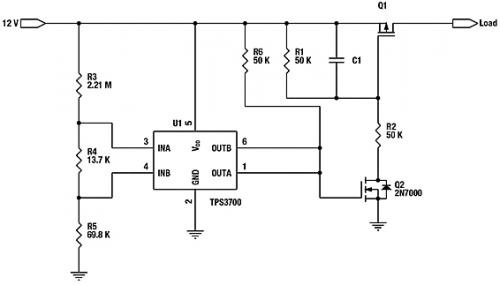Manage electronic system surges and enhance system protection
Time:2023-03-21
Views:1130
The methods for avoiding circuit system failures in electronic products and managing power-on surge currents have made significant progress, evolving from simple fuses or P-channel FETs to more advanced solutions. These highly integrated solutions not only manage surge inflow into the system, but also ensure that transmission elements (typically FETs) are within a secure work area (SOA). This can significantly improve control and fault telemetry for system diagnosis. This article will discuss enhanced solutions for system protection and key related issues.
Simple system protection
The simplest form of protection for electrical circuits is a suitably rated fuse. A thorough study of the appropriate solutions for your current application will reveal a variety of fuses to choose from, including but not limited to fast fuses, slow fuses, polysilicon fuses, and smart fuses. The reason why there are different types of fuses is that each type of fuse has its own advantages and disadvantages.
As the name implies, a fast fuse can quickly fuse, which means that it is likely to cause erroneous jumps, leading to product recycling. Therefore, when selecting this type of fuse, it should be noted that the rating reduction should be higher than 50%, that is, the fuse rating for 5A rails should be higher than 10A to avoid application error failures.
The slow fuse takes a long time to start fusing, but it can still experience erroneous jumps, so the rating is usually lowered by at least 50%.
The advantage of polysilicon fuses is that they can be automatically restored if faults are eliminated, but there is also a small cost involved. The subsequent jump point threshold for each jump will decrease, making it easier to jump. Therefore, the probability of erroneous jumps increases over time.
Intelligent fuses or three-terminal fuses are devices that can be blown on demand or in the event of overcurrent. This type of fuse typically has a higher cost than the above described fuse and requires the power supply voltage to be maintained at a certain height before the fuse can be blown. Otherwise, in the event of a fault, all components will be very hot and may not be able to shut down safely.
All four solutions mentioned above have two major problems that can lead to error jumps. Firstly, they are unable to limit the surge current that enters the system during or after power-on; Secondly, due to the need to lower the rating, they may allow a large amount of current to pass through in the event of a system fault, causing the faulty circuit system to overheat, causing more serious faults. For example, a 12V system with a 5A rating may attempt to use a fuse with a current rating of 10A or higher. If a good power source is short-circuited, the faulty circuit may experience up to 120W of power.
Surge management
Most false jumps are caused by surge currents. A low-cost method to minimize surge currents may be implemented using a P-channel FET and two resistors and capacitors (Figure 1).
Of course, such circuits begin to come into contact at the moment the input voltage appears, so it is usually necessary to keep the circuit disconnected before detecting a good power signal. Figure 2 shows a possible implementation using a window comparator that ensures a 12VAC adapter voltage between 10.8V and 13.2V. As long as a broad power supply voltage window comparator such as the TPS3700 finds the adapter in the active voltage window, the power path through Q1 can be enabled.



Figure 1. Simple surge management solution

Figure 2. Using TPS3700 as an AC adapter detector
The above methods may be feasible for some design schemes, but there are also some inherent problems:
Depending on the size of the load capacitance, both methods may affect the safe working area (SOA) of the FET;
Once enabled, it is not possible to limit the current entering the load;
If the load is short-circuited, the FET may fail during startup, which may occur before the fuse. It is best to use a FET with a rated power consumption that is much higher than the application requires to reduce the risk, which in turn can lead to an increase in the cost of the solution.
In case of system startup or system level failure, there must be better system protection methods.
|
Disclaimer: This article is transferred from other platforms and does not represent the views and positions of this site. If there is any infringement or objection, please contact us to delete it. thank you! |











